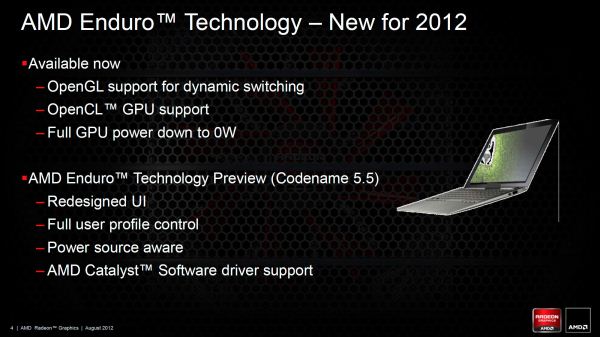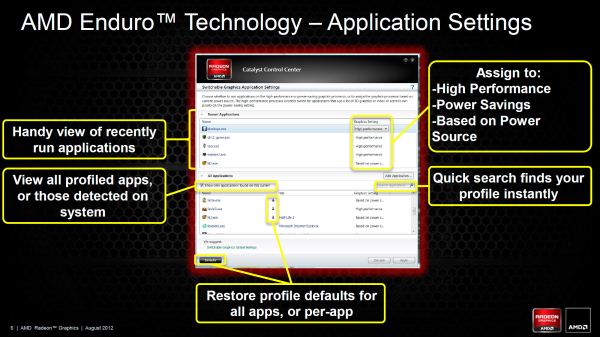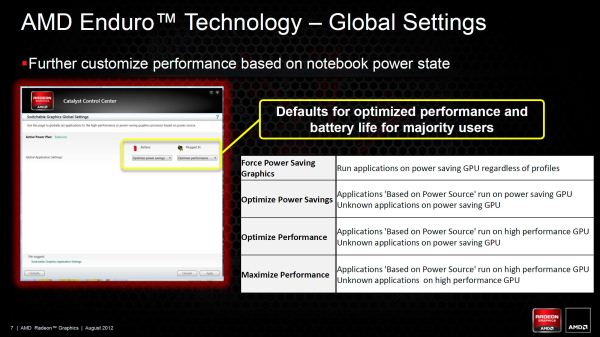AMD’s Enduro Switchable Graphics Levels Up
by Jarred Walton on September 6, 2012 3:00 AM ESTNew for Mid-2012: “Enduro 5.5” Enhancements
When AMD created the Enduro brand, they were really almost where we wanted them. They had dynamic switching with support for most of the latest games and applications, and when it worked properly it would be difficult to tell if you were using an NVIDIA or an AMD dGPU. The problem was when things didn’t work and you had to go into the drivers, and there were several problems. OpenGL support was totally out, many of the latest games were also missing default profiles (and sometimes wouldn’t let you properly specify the correct GPU), the UI was obtrusive and sometimes hard to use (particularly for power users), and the drivers were dictated by the laptop manufacturers and were usually months old at launch and never updated.
While the UI seems like a minor thing to fix—I would have thought one or two months to improve the UI would have been sufficient—at least prior to the forthcoming update it remained largely unchanged. The lack of AMD-provided driver updates was really the major issue, because everything else could potentially be fixed with new drivers and you would never know. The other areas like OpenGL/OpenCL and support for various games/applications should improve over time as well, provided you can get drivers. That brings us to the upcoming Enduro release, scheduled to come out sometime this month or next. Officially it’s still just Enduro, but to help differentiate between the previous Enduro release and the upcoming release we’ll sometimes refer to the new version as “Enduro 5.5”.
The biggest news with the latest iteration of Enduro is that AMD is planning to make universal reference drivers available for all the Enduro laptops. It’s not clear precisely what that means, but potentially any laptop with Dynamic Switchable Graphics or later (e.g. PX4.0 and later) would be supported by AMD’s “reference” drivers. That’s huge, and if AMD can deliver it will assuage most of our concerns with their hardware/software. Hopefully none of the OEMs get bent out of shape or refuse to allow support, which is a problem we've seen in the past. We should see the first public release in the next month or two, and then another release somewhere in the November/December timeframe.
Besides the availability of driver updates, the UI also receives a much needed overhaul, providing both regular and power users all the options they’re likely to need as far as control of graphics switching is concerned. Open up the switchable graphics options and the top section remains largely the same, but the bottom now allows you to see all application profiles (or just the profiles for detected applications). There’s also a quick search option that works both on executable name and application/game name (e.g. HL2.exe or Half-Life 2 will both find the profile for Half-Life 2). From either list (recently used apps up top, or all apps at the bottom), you can set the GPU profile.
Where previously there were two settings (three if you count “Not Assigned”), there are now three options. As before, “Power saving” sets an application to run on the integrated graphics while “High performance” sets an application to run on the discrete GPU. The new third option is “Based on power source”, which does precisely what you’d expect: plug the laptop in and the apps with this setting will run on the discrete GPU; switch to battery power and they’ll run on the integrated graphics. For many users, everything could default to “Based on power source” and they would be happy, but certainly there will be times where you’re running on battery power but still want to use the dGPU and the drivers give you that option. Should things get squirrelly, you can also reset applications individually or globally to their default settings. It’s worth noting that the power state aware setting is something that NVIDIA currently does not implement, requiring manual intervention if you wish to override your normal settings—though how often people are using apps that require the dGPU while on battery power is something we could debate.
Besides the individual application profiles, AMD is also adding a new area to their drivers: Switchable Graphics Global Settings. This is something you could sort of get before with some laptops, but previously it involved changing from Dynamic Switchable Graphics to manual switching (i.e. switching based on power source) and then forcing the laptop into High Performance or Power Saving mode if you wanted to be low power while plugged in or high power while unplugged. That was clunky and at least in the case of the Sony VAIO C we tested it caused flickering similar to the old switchable graphics, with the dGPU drivers getting unloaded and iGPU drivers getting loaded (or vice versa), with some work behind the scenes copying context from one GPU to the other. It worked but it wasn’t elegant; perhaps more importantly, Microsoft doesn’t want anyone doing this with Windows 8 and thus new laptops won’t be able to get a Windows 8 sticker if they use this method of switching (which basically means no new laptops will do this). To make up for the loss of this functionality (which some people still prefer), AMD has added a new global settings section.
Unlike the individual application profiles, the global settings gives you four options each for Battery and Plugged In. The top two options are similar in most cases and will generally run most applications on the iGPU, and the same goes for the bottom two modes where you’ll run most apps on the dGPU. The difference is that “Force Power Saving GPU” will run all applications (regardless of what the custom profile says) on the iGPU, essentially disabling the dGPU completely. “Optimize Power Savings” in contrast will run all unknown or “Based on power source” applications on the iGPU while respecting the application profiles where they exist. “Optimize Performance” is sort of the reverse of that, running all “Based on power source” applications on the dGPU while leaving unknown applications on the iGPU. Finally, the “Maximize Performance” option runs all unknown and “Based on power source” applications on the dGPU—but applications specifically set to use the iGPU will continue to do so.
The reason for that last discrepancy (e.g. why you can’t simply run everything on the dGPU and forget about the iGPU) is that certain tools have to run on the iGPU. Intel’s drivers are one example—loading those up on the dGPU would cause problems. Intel’s WiDi is the only other I could find on my particular Clevo notebook. We were told that some of the laptop utilities like an overlay showing percentage of brightness, volume, etc. may also need to run on the iGPU. Besides the few applications that have to run on the iGPU, any applications that are set to Power Saving will continue to use the iGPU—and this makes sense as there are a lot of applications that can be set to run on iGPU/dGPU that have no need of higher performance GPU options (several anti-virus utilities come to mind, where they're starting to create a 3D context for their UI). The net result is that other than a few specific applications where the profile will exist and be locked to the iGPU, with no option to change to dGPU, everything else that uses higher function graphics can be customized to run on a specific GPU, but if you set something to iGPU presumably you want it to always run there—otherwise you would use the “Based on power source” setting.
A full set of screenshots from all the driver screens is available in the gallery below if you’re interested.
One final topic worth discussing is Windows 8. Certainly there are owners of existing laptops with switchable graphics that are wondering if they can upgrade to Windows 8 and what will happen. We’ll have to see how this actually plays out, but it sounds like the earlier versions of PowerXpress (3.0 and earlier) will probably get support with one driver bundled with Windows 8, and that may be it—but there’s always the possibility for the laptop OEMs to release their own updates, or for AMD to roll out additional drivers for older laptops. The potential for PowerXpress 4.0 and later laptops to get regular driver updates (for Windows Vista/7/8) is there, but until we actually start seeing public driver releases AMD hasn’t fully committed to supporting all of those laptops.



















200 Comments
View All Comments
JarredWalton - Thursday, September 6, 2012 - link
I have a P170EM with the beta drivers, and AMD says they're basically undergoing final QA before release this month or next. I brought up this issue over a year ago, so obviously AMD is moving slowly, but it looks like they're about ready to address things. Finally. I wouldn't go out and buy a 7970M solution today with the intention to wait for the public driver updates to start coming, but rest assured we will be testing with the public drivers when they launch, and when they update again we'll test again.I should also note again (as I did in the article) that the GCN architecture cards have not had the best performance consistency since launch until the latest drivers -- and that's on the desktop. Everyone running GCN on laptops is basically looking at drivers that are 3+ months old (unless they have a laptop that doesn't use Enduro, in which case they ought to have been able to update to the 12.7 Catalyst release).
arcticjoe - Thursday, September 6, 2012 - link
Jarred download MSI Kombustor (its a very small download and has a GPU utilization graph so you can see the Enduro issue very quickly) and run it with default settings (DX10 and DX11 modes work ok and give you 99% utilization and good fps). If your utilization is bellow 99% then these new drivers fixed nothing.JarredWalton - Thursday, September 6, 2012 - link
Note that there are no "DX10 or DX11" modes -- everything is OpenGL as far as I can see. So even though the EXE name is msikombustordx11.exe, the rendering is done via OpenGL. That could be a problem, as up until Enduro OpenGL wasn't even supported by AMD's dynamic switchable graphics, but it appears to be working (mostly?) now.Utilization for the Furry and Stessy Test (GL4) starts low for the first ~10 seconds (and there were a couple rendering glitches) and then jumps to 98% with no more flashes or rendering errors. FPS at 1080p 2xAA is 13. Other tests show a similar low GPU utilization for the first few seconds and then jump to 90% or higher. I'm not sure what's going on, but I don't think the GPU utilization is accurate right at the start.
Anyway, saying "anything below 99% in Kombustor isn't right" seems rather extreme, particularly since Kombustor is based off of Furmark. What about GPU utilization in games? Let me run a few tests, but if you know of any specific games where there are problems, I can try to test those.
arcticjoe - Thursday, September 6, 2012 - link
Thanks for testing Jarred. I think (i'm at work at the moment, cant check) there is a tab for a "burn in test" which allows your to switch rendering between openGL and DX9/10/11.JarredWalton - Thursday, September 6, 2012 - link
Okay, that helps -- I wasn't sure exactly which test you wanted. Here are the full results at 1080p:OGL2: 92% utilization
OGL3: 91% utilization
DX9: 90% utilization
DX10: 99% utilization
DX11: 99% utilization
There's still a ~5 second gap between starting and full load showing up, but that appears to be a "works as intended" sort of thing. Batman: Arkham City incidentally is showing 99.7% GPU load at 1080p Extreme settings.
If you have specific games you'd like me to check, let me know. I'm going to see about digging into this a bit more today.
Seanzky - Thursday, September 6, 2012 - link
Thank you!arcticjoe - Thursday, September 6, 2012 - link
Batman is one of the games I get unstable utilization (60-90%), so 99% sounds very promising.JarredWalton - Thursday, September 6, 2012 - link
So just a quick update:At extreme settings, GPU utilization is 99.7%. At Medium settings, however, GPU utilization is much lower: around 47%.
I ran a similar test with DiRT 3. At Ultra High, I got GPU use of around 90% on average. Drop that to Medium and utilization drops to more like 50%.
I guess the question is whether the GPU utilization is low because AMD is specifically trying not to use more GPU than needed (e.g. once you break 60 FPS, there's no much point in rendering faster on a 60Hz LCD panel), or if there's some other reason for the low GPU use. I'd also guess that it can be fixed with drivers; how high a priority that is remains to be seen.
arcticjoe - Thursday, September 6, 2012 - link
I wouldnt mind if utilization dropped when 60fps limit is reached, the problem at the moment is that I get the same 20-40 fps (just lower utilization %) whether I am in Ultra or Low settings. So in BF3 MP on High settings I could get higher fps with 6970m than with my 7970m, when on paper 7970m should be nearly twice as fast.gamoniac - Thursday, September 6, 2012 - link
Thanks for the info about 20-40fps. I was thinking it would be desirable for the GPU to run optimally (not 99% all the time) once 60fps is hit, but if in fact the games are rendered at such low frame rate, it is a problem. Perhaps Jarred can post the FPS info as well.